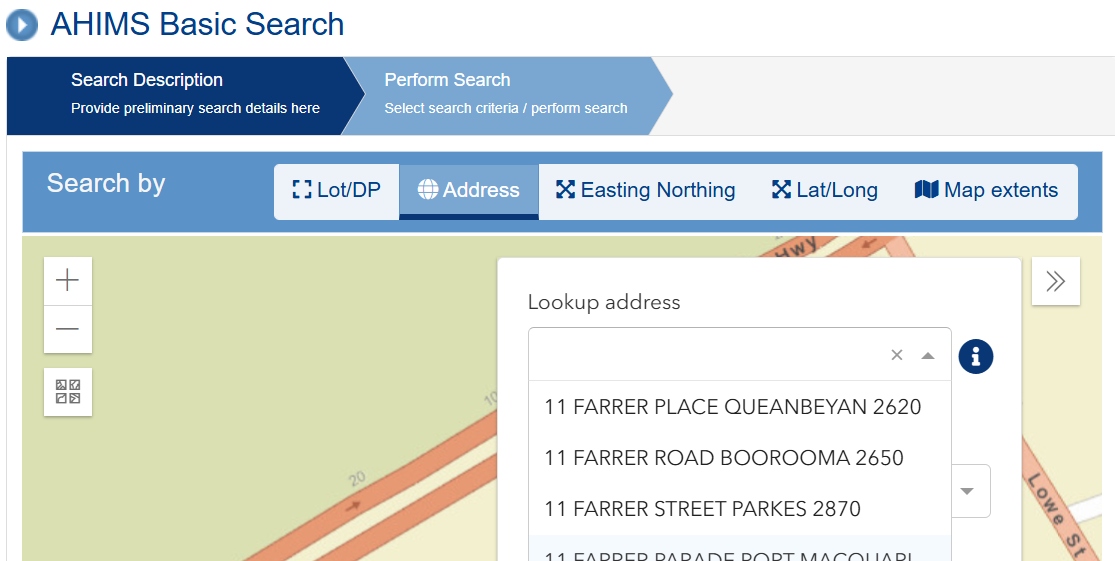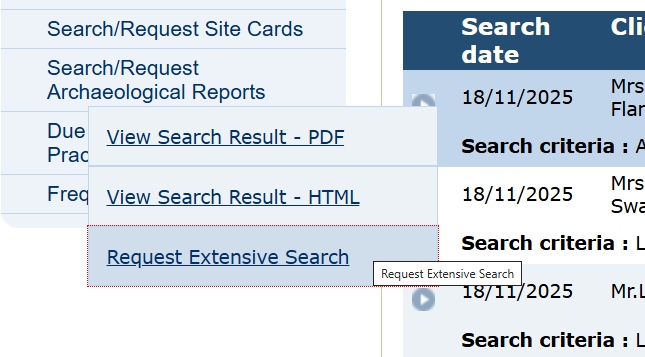AHIMS has been upgraded to enable the instant delivery of site cards and reports, and automated payments. This upgrade went live in late 2023. Manual invoicing will be discontinued after this date. This upgrade does not change the way Aboriginal cultural heritage information is accessed and managed in AHIMS.
Do you have questions about changes to AHIMS?
Find answers to the most frequently asked questions about the new automated service.
AHIMS is a digital database that stores information about Aboriginal cultural heritage across New South Wales, including recorded sites, archaeological reports and cultural heritage assessment reports.
It’s an important tool for heritage professionals, planners, researchers and community members to enable proper consideration of Aboriginal cultural heritage in land use planning, development and conservation.
See below for how to search and request information from AHIMS about:
- Aboriginal Places declared by the Minister for Heritage that have special significance to Aboriginal people
- other significant Aboriginal sites and objects.
These are collectively referred to as Aboriginal ‘sites’ in the database. You can do searches using interactive maps, coordinates, addresses and shapefiles. AHIMS is continually updated to reflect new discoveries, site recordings and changes in land use.
AHIMS offers services including:
- requesting copies of archaeological reports and site cards
- requesting sensitive information under an Aboriginal heritage information licence agreement.
Search Aboriginal sites for due diligence
Due diligence searches are typically done to:
- identify known Aboriginal sites within a project area
- assess potential impacts on cultural heritage
- inform environmental planning instruments
- support Aboriginal cultural heritage assessments.
They are often done by developers, consultants, government agencies and landholders before submitting planning proposals or development applications.
Before carrying out any on-ground work or activity, thought must be given to how it might affect Aboriginal sites. For some activities, the National Parks and Wildlife Act 1974 requires the exercise of due diligence to see if Aboriginal sites might be harmed by activities. Checking AHIMS is part of this due diligence.
Refer to the Due diligence code of practice for the protection of Aboriginal objects in New South Wales if you are doing a search as a part of the due diligence process.
The code of practice sets out the reasonable and practicable steps which individuals and organisations need to take in order to:
- identify whether or not Aboriginal objects are, or are likely to be, present in an area
- determine whether or not their activities are likely to harm Aboriginal objects (if present), and
- determine whether an Aboriginal Heritage Impact Permit (AHIP) application is needed.
How to use AHIMS
Log in or register
New users must register for access to search AHIMS. Existing users can log in using their credentials.
How to perform a basic search
Basic searches allow users to quickly locate Aboriginal heritage sites using geographic inputs free of charge. The results are displayed instantly and can be downloaded as a PDF.
Enter search details
- Employer affiliation: Indicate whether you are searching on behalf of your employer.
- Employer selection: If 'Yes', choose your employer from the dropdown list.
- Reference label: Enter a reference name (for example, project code, purchase order) to help track your search.
Proceed to search criteria
Click the Next button to access the search interface.
Lot/DP search
- Enter the Lot and Deposited Plan (DP) number in the format Lot/DP (for example, 123/456).
- The system will auto-suggest matching entries.
- Select the correct entry to zoom to the location.
- Use the magnifying glass icon to adjust buffer settings.
- Change the base map using the icon on the left.
- Click Search to generate results.
Street address search
- Select the street address option.
- Begin typing the address; matching entries will appear.
- Select the correct address to zoom to the location.
- Click Search to view results.
Easting/Northing search
- Enter minimum and maximum Easting and Northing values.
- This defines a rectangular search area.
- Buffer settings are not available.
- The map will zoom to the best-fit extent.
- Click Search to generate results.
Latitude/longitude search
- Enter minimum and maximum latitude and longitude values.
- For Southern Hemisphere locations, 'From' latitude must be more negative than 'To'.
- The system will zoom to the defined area.
- Click Search to view results.
Map extent search
- Use zoom controls or mouse navigation to define the area of interest.
- The visible map extent becomes the search boundary.
- Click Search to generate results.
What to do if sites are found in your basic search
If Aboriginal sites are identified within the search area, you must complete an extensive search to obtain more information.
You may also need to:
- consult with Aboriginal communities and heritage officers
- consider redesigning the project to avoid impacts
- prepare an Aboriginal Cultural Heritage Assessment (ACHA)
- apply for permits if site disturbance is unavoidable.
If no sites are found, the search report can be used to demonstrate that reasonable steps were taken to identify and protect Aboriginal heritage.
Performing an extensive search
Extensive searches provide detailed reports on Aboriginal heritage sites, including site geographical location, features, recorders, and archaeological context. These reports are delivered instantaneously after payment has been received.
If a basic search has already been completed, simply select the search and choose the option to Request Extensive Search from the menu. Follow the prompts and complete payment to obtain the search results and download the report.
How to request sensitive information under an Aboriginal heritage licence agreement
An Aboriginal Heritage Information Licence Agreement (AHILA) is required when requesting information about large geographic areas or culturally sensitive Aboriginal sites.
Examples include:
- multiple recorded Aboriginal sites across a local government area or region
- sites considered culturally sensitive
- sites located near major development projects, such as roads or infrastructure networks.
An AHILA is a formal agreement between Heritage NSW and the applicant. It outlines the terms for accessing the information and the responsibilities of the applicant in handling it.
Most AHILAs are processed within 4 to 8 weeks, allowing sufficient time for Aboriginal organisations to review and provide endorsement or feedback on the release of the information.
How to request a site card
A site card is the original document created when an Aboriginal site was recorded in the field. These records are stored in PDF format and can be requested when further details about a site are needed. Site cards may include photographs, maps, detailed descriptions of site contents, and management recommendations.
The level of detail in each site card varies depending on the time it was recorded and the effort made by the original recorder. Some cards are highly detailed, while others may be more limited in scope.
Site cards date back to the 1970s, when the original register was established by the Australian Museum. Since then, both the format and the type of information captured have evolved over time.
How to request an archaeological report
Archaeological reports, also referred to as Aboriginal Cultural Heritage Assessment Reports, are typically prepared as part of the due diligence process or during cultural heritage assessments conducted by archaeologists or heritage professionals.
These reports often include background context, methodologies, detailed analysis, conclusions, and recommendations related to Aboriginal cultural heritage within a specific area. They provide valuable insights and are stored in PDF format. Copies can be requested when additional information about a site is required.
List of fees
The table outlines available services and fees. Aboriginal individuals, Aboriginal community organisations and some government agencies are eligible for fee waivers. Find more information on fee waivers at Aboriginal Heritage Information Management System – automated service.
| AHIMS service | What the user receives | Fee (GST exempt) |
|---|---|---|
| Report or site card | PDF document/s via email, usually after an AHIMS search | $0.40 per page (minimum charge $20 if not associated with a search service) |
| Archive visit | Access to AHIMS archive | Free |
| Archive visit – photocopy or PDF | Photocopy or PDF document/s | $0.40 per page (minimum charge $20 if not associated with a search service) |
| Search – basic | Cover letter | Free |
| Search – extensive | PDF or Excel report, and cover letter | $60 |
| Search – GIS | PDF report | $60 |
| Express search surcharge | Service provided in 2 working days | $50 |
| Data request – Aboriginal heritage information licence agreement (AHILA) | Use of, or access to, data for up to 2 years | $210 |
| Data request – resupply of data from AHILA | Resupply of data based on current AHILA (includes the new search) | $60 |
| Other – processing surcharge | Specialist services that cannot be processed under normal service conditions | $90 per hour |
Record Aboriginal sites found in New South Wales
If a new Aboriginal site is found in New South Wales, it should be recorded in AHIMS. There are 2 ways to record Aboriginal sites.
Mobile phone app
Download the free AHIMS site recording mobile app. The app was developed to make site recording easy, consistent, and more accurate. When using the mobile app to record site information, a site card will automatically be generated with the site details entered. You will be identified as a ‘recorder’ in AHIMS.
Desktop platform
Access AHIMS Site Quarantine Station to:
- view any site cards created by you
- import extensive searches from AHIMS, which can be viewed via the mobile app and used in the field
- submit an Aboriginal site impact recording form for a site impacted as part of archaeological investigation and authorised impacts under an Aboriginal heritage impact permit
- record impacts to Aboriginal sites in New South Wales in cases where a recorded Aboriginal site has been impacted by the occurrence of natural events such as wildfires or floods. This form can also be used to log accidental or unauthorised impacts to recorded sites. Note: this form is only for sites already recorded in AHIMS.





